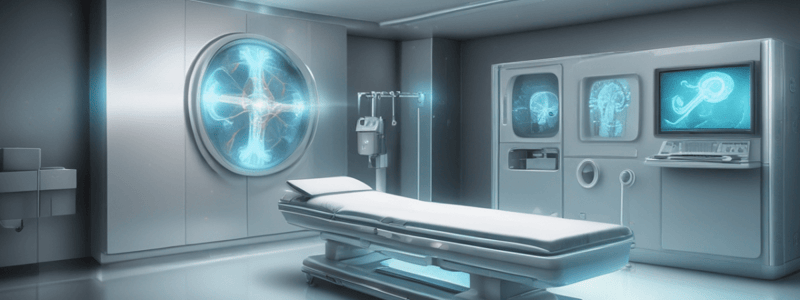Podcast
Questions and Answers
What principle does the physics of diagnostic X-ray primarily rely on?
What principle does the physics of diagnostic X-ray primarily rely on?
- The absorption of X-rays by different tissues (correct)
- The generation of electromagnetic waves
- The refraction of X-rays in the air
- The reflection of X-rays off surfaces
Which of the following factors most affects the quality of an X-ray image?
Which of the following factors most affects the quality of an X-ray image?
- The amount of radiation exposure
- The distance between the source and the patient
- The type of detector used
- The energy level of the X-ray photons (correct)
What is the main function of the X-ray tube in diagnostic imaging?
What is the main function of the X-ray tube in diagnostic imaging?
- To convert electrical energy into X-ray radiation (correct)
- To store energy for future imaging
- To amplify the X-ray signal after exposure
- To filter out low-energy X-rays
Which term describes the process of using X-rays to create images of the body’s internal structure?
Which term describes the process of using X-rays to create images of the body’s internal structure?
What role does contrast media play in X-ray imaging?
What role does contrast media play in X-ray imaging?
Flashcards are hidden until you start studying
Study Notes
Medical Physics Overview
- Medical physics bridges the gap between physics and clinical medicine, focusing on the application of physics in healthcare and diagnostic imaging.
X-Ray Physics Fundamentals
- X-rays are a form of electromagnetic radiation used primarily for diagnostic imaging.
- Generated by electrons accelerating towards a metal target in an X-ray tube and suddenly decelerating, leading to radiation emission.
Interaction of X-Rays with Matter
- X-rays interact with tissues in different ways: absorption, scattering, and transmission.
- Denser materials (like bone) absorb more X-rays, leading to higher contrast on images.
X-Ray Imaging Techniques
- Two primary forms of X-ray imaging: plain film radiography and digital radiography.
- Advances in technology have transitioned many facilities to digital methods for enhanced image quality and reduced radiation exposure.
Safety and Dosimetry
- Strict guidelines and protocols are essential to minimize radiation exposure to patients and healthcare providers.
- Dosimeters are used to measure radiation levels and ensure safety standards are upheld.
Clinical Applications
- X-ray imaging is critical in diagnosing fractures, infections, tumors, and more.
- It is often used in combination with other imaging methods for comprehensive assessments.
Future Developments
- Ongoing research focuses on improving imaging technologies, reducing radiation exposure, and enhancing image processing techniques.
- Artificial intelligence is increasingly being integrated to aid in image analysis and interpretation.
Studying That Suits You
Use AI to generate personalized quizzes and flashcards to suit your learning preferences.




